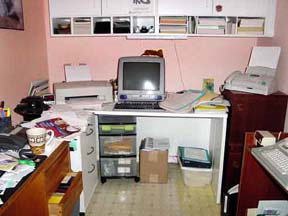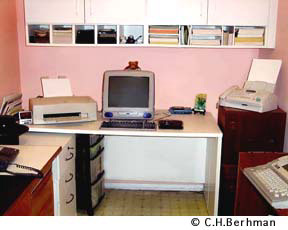Marketing News
 |
 |
|
|
Here we go - one more article on organizing! ... Do at least one thing you like to do every day... I guess it is a paradox of our time. On the one hand we have computers that were to eliminate most of the paper we had to deal with. On the other hand, we are receiving a blizzard of paper work in our offices and homes from faxes, scanners, mail, and email that we print out. When we go out into the world we receive business cards, brochures, newsletters, product information, etc. And - lets not forget all of the books, binders, cd's and instructional pamphlets in connection with our computers and software programs! The demand for paper-based information has increased substantially - approximately 25% each year! And there is no slowing down in sight. An recent article in The Los Angeles Times states "'Electronic communications have tremendous potential to reduce paper consumption in the future, but unfortunately there's been no noticeable change in our paper consumption and wood-product consumption to date. It continues to increase'" "One reason
could be that environmental gains from the use of technology are offset
by the tendency to print things out."
We definitely have more paper to deal with and we are requiring more and more space and filing equipment to store all of the information that we are receiving. There are now well over l,000 professional organizers as well as business coaches, 12-step programs and other services that address the fact that we have purchased, stored, printed, received or otherwise accumulated much more information and stuff that we can get a handle on. Business
productivity depends on how quickly we can access paper-based information.
95% of stored information will continue to be in paper format well into
this century. For the professional photographer I believe there is even a greater challenge to setting up a comprehensive system for the management of records, equipment and product. The professional photographer not only has business documents, accounting records etc., but has equipment that must be insured, maintained and stored, as well as digital files negatives, prints, contact sheets, slides, paper and copies that are ever-accumulating. With that
being said, many of you may want to take on the challenge of re-organizing
your office/work area. The following are suggestions to make the task
easier: Main questions to ask yourself:
What this
accomplishes is that the problem/challenge is being acknowledged and the
vision is brought into focus. If the commitment
is made to revamp the office/work area, a plan of action should be decided
upon. A step-by-step
approach should include: Purging of
old papers and files Set up a
color coded filing system, for example one specific color for client files,
another for administration, etc. Incrementally
go through and purge old reading material. Determine what articles and
books need to be retained for future reference. (Scan table of contents
on magazines and cut out the articles that interest you and throw out
the rest of the magazine! Get rid of non-essential reading material. How should records be cataloged for easy retrieval? Once the criteria is established for all forms of records and work flow, the second step is to design the system. Questions to ask re the design of the system:
A good question to ask is: "If I needed someone to retrieve something from my office or work area with my instruction, how difficult would it be for them to locate what they needed?" Defining the rules and boundaries of the system will keep everyone on track. Establishing the criteria, setting up the system and implementing the system will yield many benefits. Some of the
benefits include increased focus, defining of goals and business objectives,
having a business environment that is satisfying to work in and reduces
stress, errors and miscommunications. Give organization and in particular organization of paper a top priority. Just because something has always been done a certain way does not mean it cannot be revamped or modified. There is
a solution for every problem. Finding solutions will create a happier
work environment. The following
are suggestions to reduce business and personal stress factors. Feel free
to add your own personal favorites to the list and visit it often until
the new habits and thought patterns become engrained:
Block out
time to read on a weekly basis. Stop worring.
Either do something about it if you can or Dee E. Behrman |

|
I started Fresh Lists in 1994, because I was unable to find a company which provided the services I needed for a mailing list and at reasonable prices. At that time I was representing photographers. Within a few years the demand for my lists became a full time business. The mailing lists are specifically designed for photographers and illustrators. You will be able to reach those individuals who purchase photography, commission photography and illustration services on a consistent basis. I update the lists twice a year in January and July. Included in these lists are the name, title, address, phone, e-mail and web page. Most of the agency lists are categorized, so you are able to select potential clients faster (e.g. Annual Report, Auto, Food, Travel). The Magazine list I divide into categories as well (e.g. Business, Fashion, Film, Home/Garden, Travel). To see all the categories go to my website at www.freshlists.com. To make it it easy for you to use Fresh Lists, I deliver the lists on a free database program. With the information provided you can search the list by title, area code, company, categories etc.
It is as easy as 1-2-3 to print labels and prepare for an e-mail campaign. My goal is for you to keep track of your mailing lists with the least amount of effort. I provide unlimited technical support for any questions that may arise. When I purchased lists as a photographers rep, I couldn't find any lists that would allow me to keep personal notes. It was important for me to keep track of who I mail promo pieces to and also the conversation of each of those phone calls. I spent endless hours comparing the old list to the new one when I would purchase another list. Fresh Lists has an easy to use update system, so in no time you have updated your lists, kept all your notes and ready for the next campaign. The lists
we currently have available are: NEW LIST We provide
unlimited technical support. Mention Women in Photography when you purchase a list to get the special price through February 15, 2002. Please contact
me at 800-322-3985 with any questions you may have. You can also visit
our web site at www.freshlists.com. Karen Hansen 800-322-3985 "Fresh
List made the difference Karen Hansen, Fresh List turned my buisness around
! WIPI uses Fresh List for our data base, it's easy and convenient for all the information we handle on our members. Karen is there to take your calls and help you whenever you need her. A good investment and Karen will support a discount rate to "WIPI verified" members. Part TWO of a three part series: CREATING
SUCCESS
|
For articles, see F2-eZine Content Archive #9 - January-March 2002